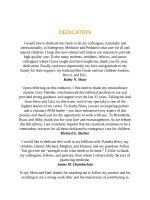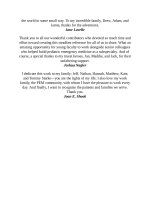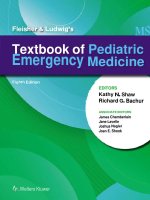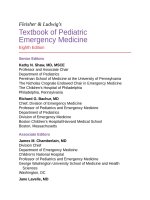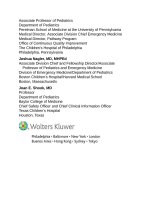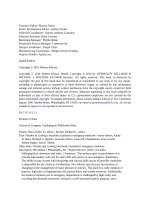Pediatric emergency medicine trisk 0243 0243
Bạn đang xem bản rút gọn của tài liệu. Xem và tải ngay bản đầy đủ của tài liệu tại đây (70.04 KB, 1 trang )
therapy are rarely given in ED phase of care.
Sodium Bicarbonate
Bicarbonate therapy may contribute to respiratory acidosis and a worsening
intracellular acidosis, which may actually impair myocardial and cerebral
function. In prolonged resuscitations, after establishment of adequate ventilation,
bicarbonate may be given to treat documented metabolic acidosis or
hyperkalemia using arterial blood gases and serum chemistries to guide
administration. Use 0.5-mEq/mL (4.2%, half-strength) solution to decrease
effects of hypertonicity. Little research data exist to support the choice of other
buffers, such as tris(hydroxymethyl) aminomethane (THAM), for documented
metabolic acidosis; practitioners may use this to reduce the occurrence of
hypernatremia.
Naloxone Hydrochloride
Naloxone is a narcotic antagonist that reverses narcotic-induced respiratory
depression. Naloxone is not recommended for the initial resuscitation attempts in
the newly born. The focus of the resuscitation remains the same, providing
adequate respiratory support to correct abnormalities in ventilation and
circulation. Naloxone given to the newborn of a mother suspected of narcotic
addiction may precipitate acute narcotic withdrawal and seizures.
Atropine
Atropine is not recommended for acute neonatal resuscitation as vagal stimulation
does not cause bradycardia in neonates. Furthermore, many investigators believe
that the vagally mediated bradycardia response to hypoxia is a valuable reflex to
guide resuscitative efforts and should not be pharmacologically abolished by
atropine.
Artificial Pulmonary Surfactant
Newborns who require intubation due to the respiratory distress associated with
insufficient surfactant production may benefit from replacement therapy with an
artificial surfactant product. Prematurity of less than 35 weeks is the most
common indication for surfactant use. Replacement surfactant is delivered to the
pulmonary bed via an ET tube. Use of surfactant in the ED should be done in
consultation with a neonatologist.
Antibiotics

